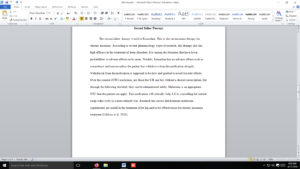Insomnia and Sleep Disorders
Use APA 6th Edition Format and support your work with at least 3 peer-reviewed references within 5 years of publication. Remember that you need a cover page and a reference page. All paragraphs need to be cited properly. Please use headers. All responses must be in a narrative format and each paragraph must have at least 4 sentences. Lastly, you must have at least 2 pages of content, no greater than 4 pages, excluding cover page and reference page.
I will post your Case Study #2 Grades and email your feedback by Wednesday. Therefore, I will extend your case study due date, case study #3 is Due 7/31/2020 by 11:59pm EST. If submitted after 7/31/2020, points will be deducted. If any questions, please do not hesitate to contact me.
Case Study #3: Insomnia and Sleep Disorders
S.H., age 47, reports difficulty falling asleep and staying asleep. These problems have been ongoing for many years, but she has never mentioned them to her health care provider. She has generally “lived with it” and self-treated the problem with OTC Tylenol PM. Currently, she is also experiencing perimenopausal symptoms of night sweats and mood swings. Current medical problems include hypertension controlled with medications. Past medical history includes childhood illnesses of measles, chickenpox, and mumps. Family history is positive for diabetes on the maternal side and hypertension on the paternal side. Her only medication is an angiotensin-converting enzyme inhibitor and diuretic combination for hypertension control. She generally does not like taking medication and does not take any other OTC products.
Diagnosis: InsomnIa
1. List specific goals of therapy for S.H.
2. What drug therapy would you prescribe? Why?
3. What are the parameters for monitoring the success of the therapy?
4. Discuss specific patient education based on the prescribed therapy
5. List one or two adverse reactions for the selected agent that would cause you to change therapy.
6. What would be the choice for second-line therapy?
7. What OTC and/or alternative medicines might be appropriate for this patient?
8. What dietary and lifestyle changes might you recommend?
9. Describe one or two drug–drug or drug–food interactions for the selected agent.
Answer preview
The second inline therapy would be Estazolam. This is also an insomnia therapy for chronic insomnia. According to several pharmacology types of research, this therapy also has high efficacy in the treatment of sleep disorders. It is among the therapies that have lower probabilities to adverse effects on its users. Notably, Estazolam has no adverse effects such as somnolence and nausea unless the patient has withdrawn from the medication abruptly. Withdrawal from the medication is supposed to be slow and gradual to avoid the side effects. Over the counter (OTC) medicines, are those the S.H can buy without a doctor’s prescription, but through the following the label, they can be administered safely. Melatonin is an appropriate OTC that the patient can apply. This medication will critically help S.H in controlling her natural sleep-wake cycle in a more relaxed way. Research has shown that hormone melatonin supplements are useful in the treatment of jet lag and so its effectiveness for chronic insomnia treatment (Edelson et al. 2020).
[884 Words]

Insomnia and Sleep Disorders

